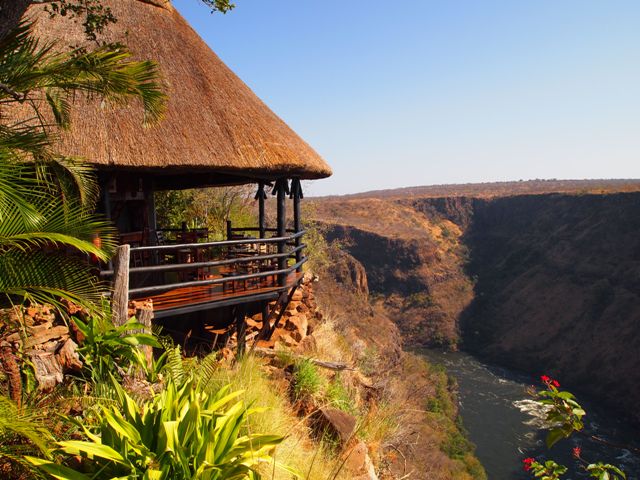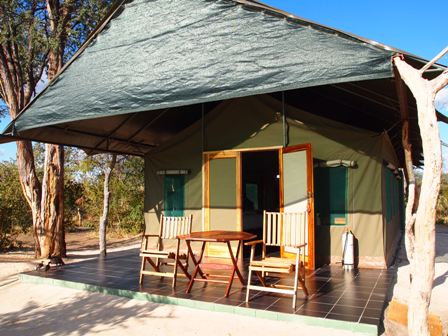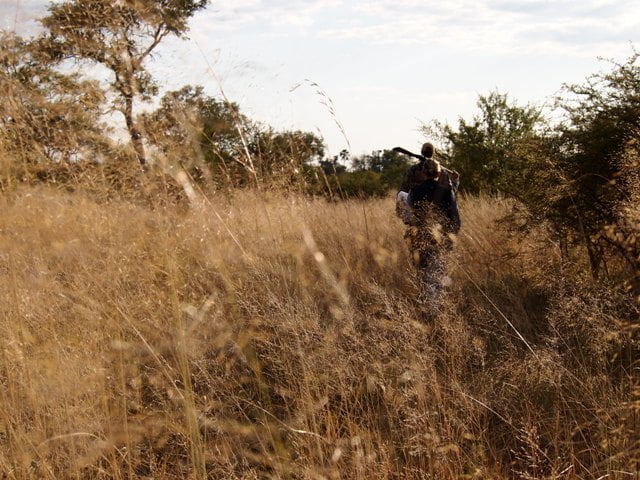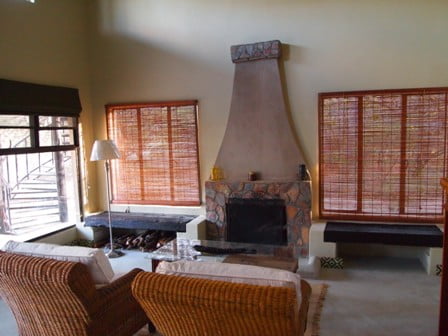In May 2013, Tad conducted an extensive educational in the Victoria Falls and Hwange regions of Zimbabwe, visiting many lodges and camps including the Imvelo Safari Lodges properties. It was on this trip that he first met Mark Butcher, Imvelo’s founder and director and our future partership was born! Tad will be updating this trip report on his next visit to Zimbabwe, including reports on the extensive refurbishments made at Gorges Lodge as well as their new Zambezi Sands River Lodge and Jozibanini Camp. For now, enjoy his first impressions of Imvelo and their wonderful lodges.
Gorges Lodge, Victoria Falls

One of three properties owned and managed by Imvelo Safari Lodges, Gorges Lodge is perched on the very edge of Batoka Gorge, 250 breathtaking meters above the Zambezi River (for rafters, it overlooks rapid 19). Located about 25-30 minutes from Vic Falls on a dirt track, Gorges has 10 thatch and stone cottages that sit literally on the precipice of the gorge. Seriously, if you’re afraid of heights, this place might not be for you! It is an absolutely spectacular location and completely unique in the area. The gorge is home to an incredible array of raptors – eagles, falcons and more – that captivate as they effortlessly soar above the gorge looking for prey. The manicured gardens that envelop the cottages and main lodge are lovingly cared for by the staff and offer a lush, verdant oasis from the dry bushveld. There are plans to expand the pool area next to the main lodge, creating a more inviting patio for lounging and a larger pool.
The cottages are a bit dated and basic but comfortable (July 2014 note: a major refurbishment is now in the works. See below for updated images of the Gorges chalets). This is 3-star accommodation ( with 5-star location and service from the on-site managers and local staff.
Bomani Tented Camp, Hwange National Park
We spent the next two days exploring the farther reaches of Hwange National Park beginning with the two Imvelo properties in the far southeast edge of the park – Bomani Tented Camp and the brand-new Camelthorn Lodge. Reaching this remote corner of the park takes some effort, at least via road transfer. It’s about 2.5 hours on a tarmac road to Halfway House (between Vic Falls and Bulawayo) and then another hour and a half on a dirt track through the thick Ngamo forest, before reaching Bomani. Because the bush is so thick in this area, seeing game isn’t easy so I wouldn’t really qualify this as a proper game drive. Alternatively, guests can arrive via air charter to Bomani’s airstrip, just 1K from the camp. It’s a bit more expensive this way but completely worth it given the amount of time saved. Bomani has a wonderfully wild, Out of Africa feel to it. This part of Hwange was once an ancient fossil lake, which was slowly buried by Kalahari sands from the west. Today, the dry, sandy and expansive plains are scattered with natural (and many man-made) water holes, which breathe life into the park and provide sanctuary to the large herds of wildlife that call it home.
Upon arrival, we were met by Imvelo’s energetic and enthusiastic owner Mark Butcher, who welcomed us with a much needed cheeseburger and beer! “Butch” is a former Hwange game ranger and Zimbabwean pro-guide turned safari operator. He is completely passionate about Zimbabwe, his camps, Hwange and the communities that benefit from his safari operations in this remote corner of the park. Having survived the dark times in the early and middle 2000’s, Butch is bullish about the future of the safari industry in Zimbabwe. He’s also cautiously optimistic about a political and economic recovery in the coming years, though this is certainly impossible to predict with Mugabe still firmly entrenched in power.

Bomani is a traditional canvas tented camp just outside the Hwange Park boundary which would be perfectly at home in the Serengeti. On one side of the main lodge overlooking a very active waterhole is the four “Spurwing” tents, the newest and largest, each with plenty of room for two twin beds, a comfortable seating area and an ensuite bath with shower (enclosed). Speaking of traditional, the hot water comes from a fire heated boiler, which is heated early in the morning and on request at other times. The tiled verandas with classic canvas safari chairs are a perfect place for early morning coffee or a night cap while watching a sky full of stars. There is one honeymoon tent which has a king size bed and open plan bathroom complete with a claw foot bathtub!
Next to the tents and closest to the lodge, there is one “Royal” suite, a fully-enclosed thatch-roofed bungalow built on-spec for a Qatari Sheik (seriously). It also has AC and satellite TV, because, well, the Sheik wanted to watch soccer (this is a great story – ask Butch). This is often used for families. On the opposite side of the main lodge are the five stilted “Hornbill” tents which look out over the grassy plains and are slightly smaller and a bit dated. A light refresh would really help.
The main wood beam and thatched lodge overlooks the Bomani pan waterhole and has an open dining area, bar and lounge, built on a raised viewing platform. The cuisine isn’t fancy but it’s filling and fresh, using only locally sourced and seasonal ingredients. I’d call it homestyle comfort food. We had a wonderful dinner under the stars of pork chops, stewed veggies and mashed potatoes, while stargazing and listening to the ele’s slurp at the waterhole next to us. It was an amazing dinner, gourmet or not.

We started the following morning with an early morning walking safari, departing on foot from the camp and across the grasslands. Bomani is located on a private concession, just outside the Hwange park boundary. There had been quite a commotion earlier in the morning and we embarked toward the kerfuffle led by Vaughn, our walking guide. The Hwange border in this region is set upon the railroad that connects Vic Falls and Bulawayo. One of the several unique features of Hwange is this rail line, which is still in use, though infrequently and unreliably. Originally there were visions of safari-goers visiting Hwange by rail but this dream died long ago. With the rail bed being raised above the surrounding plains, offers a great viewing platform and from this slightly higher vantage point, we were able to spot the cause of the zebras’ concern – a large pride of lions (8 or more females and a large male) concentrated around a kill. The jackals were converging and making quite a racket themselves. From our location above the plains and several hundred meters away, we were able to see the interaction between the predator and scavenger. The morning light was beautiful and the cats glowed. I only wish I had a better zoom lens!
In the afternoon we visited the newest addition to the Imvelo Safari’s portfolio – Camelthorn Lodge. The lodge was still under construction when we visited though they had just opened one of the forest villas for previewing. It is now open for booking as of September 2013.
Camelthorn Lodge, Hwange National Park

Camelthorn is nestled among one Hwange’s few remaining native woodlands. Because there is no waterhole in the area, the elephants have left the forest alone and it offers a Camelthorn smtruly unique safari lodge experience. The most outwardly luxurious of Imvelo’s three properties, the main stone and thatch lodge is U-shaped and wraps around its namesake, a large beautiful Camelthorn tree. It features a mostly open-fronted reception and lounge area and an enclosed dining room with three fireplaces for those chilly winter evenings! The 8 villas (only four are open now, the remaining eight hopefully by mid-2014. July 2014 note: All 8 villas are now open!) are set among the camelthorn and ebony trees. The forest villas have an open plan bedroom with king or two twins and comfy lounge area with fireplace, a separate en-suite bath and large outdoor loft/deck with hammocks for relaxing or a private dinner.
While tucked into the forest, Camelthorn is less than kilometer from the plains and a permanent waterhole with a large, underground blind. This is no ordinary blind which only for the most ardent of photographers will be willing to spend hours squeezed into. Disguised as an anthill, its 6 meters long with an en-suite flush toilet, positioned under the shade of a Leadwood tree to take advantage of evening light and sunsets for incredible elephant, toe-level shots!
Another very unique feature of Hwange and Imvelo’s two lodges is the opportunity to embark on a full-day “pump run” safari. Hwange has very few permanent waterholes due to the Kalahari sands. To keep the population of game from leaving Hwange during the dry season, a series of man-made pumps were installed in the 1920’s to provide year-round water. Today, Imvelo Safaris operate and maintain a string of waterholes along the southern side of the Park during the dry season, April – October. These must be regularly serviced by pump attendants and guests are invited to come along! They pack cooler boxes full of cold drinks and a picnic lunch and embark on a full day game drive slash pump mechanic class! Apparently the elephants are very familiar with the sound of the pumps and when one fires back to life and the water flows, they come a running!
I was very impressed with Mark Butcher and his operation in Hwange. There is clearly a real passion for Hwange, the local community and Zimbabwe as a whole. The location is a bit of a challenge but it’s well worth the flight if pax are willing to pay the cost. While Bomani is by no means dripping with luxurious touches, it has an exclusive feel given the top-notch service and its remote location. Camelthorn looks like a winner, though setting expectations is key given its unique style and woodland location. A combination of three nights each at Camelthorn and Camp Hwange (in the northern part of Hwange – see report below) could be a good one as they are both upmarket and offer two very different types of safari experiences and eco-systems. (July 2014 note: Camelthorn can now also be combined with Imvelo’s newest lodge, Zambezi Sands River Camp, a luxury tented camp located upstream of the falls along the Zambezi River and inside the Zambezi National Park (how many Zambezi’s can I squeeze into this sentence?). It offers canoing, walking and driving safaris along with all the traditional Falls activities.)



Leave A Comment
You must be logged in to post a comment.